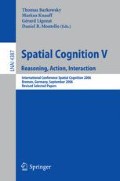Abstract
Hand-engineered definitions of spatial categories are increasingly seen as brittle and spatial concepts in human interactions may need to learn these in terms of perceptually grounded “image schemas”. Here, we present a developmental approach for the acquisition of grounded spatial schemas in a perceptual agent. We assume a capability for dynamic visual attention, and perceptual notions of wholeness and proximity. We first learn perceptual-object to linguisticname mappings from simple 2D multi-agent visual streams co-occurring with word-separated utterances. Mutual information based statistical measures are seen to be sufficient to identify nominal participants in a simple discourse, based on a synthetic model of dynamic visual attention. Next, we use this knowledge of nominals to ground the semantics of spatial relations in language.We show that a notion of proximity between perceptual objects is sufficient to obtain a pre-verbal notion of graded spatial poses. Once linguistic data is superimposed on this, simple associative structures lead to distinctions such as “in” or “out”. Finally we also show how this can lead to a model of actions, where verbs are learned along with the associated argument structures.
Access this chapter
Tax calculation will be finalised at checkout
Purchases are for personal use only
Preview
Unable to display preview. Download preview PDF.
References
Bloom, P.: How Children Learn the Meanings of Words. MIT Press, Cambridge, MA (2000)
Bowerman, M.: Learning how to structure space for language: A crosslinguistic perspective. In: Bloom, P., Peterson, M.A., Nadel, L., Garrett, M.F. (eds.) Language and Space, June 1999, MIT Press, Cambridge, MA (1999)
Casasola, M., Cohen, L.B., Chiarello, E.: Six-month-old infants categorization of containment spatial relations. Child Development 74, 679–693 (2003)
Cohn, A.G., Hazarika, S.: Qualitative spatial representation and reasoning: An overview. Fundamenta Informaticae 46(1/2), 1–29 (2001)
Coventry, K.R.: Function, geometry, and spatial prepositions: Three experiments. Spatial Cognition and Computation 1, 145–154 (1999)
Edwards, G., Ligozat, G., Gryl, A., Fraczac, L., Moulin, B., Gold, C.M.: A voronoi-based pivot representation of spatial concepts and its application to route descriptions expressed in natural language. In: Proceedings, 7th International Symposium on Spatial Data handling, Delft, The Netherlands, pp. 7B1–7B15 (1996)
Edwards, G., Moulin, B.: Towards the simulation of spatial mental images using the voronoi model. In: IJCAI-95. Workshop on the Representation and Processing of Spatial Expressions, Montreal, Canada (August 19, 1995), pp. 63–74 (1995)
Feist, M.I., Gentner, D.: Factors involved in the user of in and on. In: Proceedings of the Twenty-fifth Annual Meeting of the Cognitive Science Society (2003)
Heider, F., Simmel, M.: An experimental study of apparent behavior. American Journal of Psychology 57, 243–259 (1944)
Ford, D.P.: Learning grammatical constructions in a miniature language from narrated video events. cognitive science (2003)
Goddard, C., Wierzbicka, A. (eds.): Meaning and Universal Grammar: Theory and Empirical Findings, Amsterdam. John Benjamins [Studies in Language Companion Series, 60], vol. 1 (2002)
Itti, L.: Models of Bottom-Up and Top-Down Visual Attention. PhD thesis, California Institute of Technology, Pasadena, California (January 2000)
Flavell, J.H.: Theory-of-mind development: Retrospect and prospect. Merrill-Palmer Quarterly 50, 274–329 (2004)
Kohonen, T.: The self-organizing map. Proceedings of the IEEE 78(9), 1464–1480 (1990)
Langacker, R.: Foundations of Cognitive Grammar, vol. 1. Stanford University Press, Stanford, CA (1991)
Lockwood, K., Forbus, K., Usher, J.: Spacecase: A model of spatial preposition use. In: Proceedings of the 27th Annual Conference of the Cognitive Science Society, Stressa, Italy (2005)
Jean, M., Mandler, J.M.: How to build a baby ii: Conceptual primitives. Psychological Review 99, 587–604 (1992)
Mandler, J.M.: Foundations of Mind. Oxford University Press, New York (2004)
Martin, B., Tversky, B.: Segmenting ambiguous events. In: Proceedings of the 25th annual meeting of the Cognitive Science Society Crucial for our Data-Collection chapter (2003)
Matsakis, P., Wendling, L.: A new way to represent the relative position between area objects. IEEE Trans. Pattern Analysis and Machine Intelligence 21(7), 634–643 (1999)
Mukerjee, A.: Neat vs scruffy: A review of computational models for spatial expressions. Representation and processing of spatial expressions, 1–37 (1998)
Mukerjee, A., Vaghela, P.B., Shreeniwas, V.: Pre-linguistic verb acquisition from repeated language exposure for visual events. In: Proceedings International Conference on Natural Language Processing (ICON-2004) (19-22, 2004)
Oates, T., Cohen, P.R., Atkin, M.S., Beal, C.R.: Building a baby. In: Proceedings of the 18th annual conference of the Cognitive Science Society, pp. 518–522 (1996)
Matsakis, P., Bondugula, R., Keller, J.: Force histograms and neural networks for humanbased spatial relationship generalization. In: Proceedings of Int. Conf. on Neural Networks and Computational Intelligence (2004)
Regier, T.: A model of the human capacity for categorizing spatial relationships. Cognitive Linguistics, 63–88 (1995)
Roy, D.: Integration of speech and vision using mutual information. In: International Conference on Acoustics, Speech and Signal Processing(ICASSP 2000) (2000)
Spelke, E.S.: Principles of object perception. Principles of object perception. Cognitive Science 14, 29–56 (1990)
Steels, L.: Language learning and language contact. In: Workshop Notes of the ECML/MLnet Workshop on Empirical Learning of Natural Language Processing Tasks, ECML 1997, pp. 11–24 (1997)
Vorwerg, C., Socher, G., Fuhr, T., Sagerer, G., Rickheit, G.: Projective relations for 3d space: Computational model, application, and psychological evaluation. In: AAAI/IAAI, pp. 159–164 (1997)
Author information
Authors and Affiliations
Editor information
Editors and Affiliations
Rights and permissions
Copyright information
© 2007 Springer-Verlag Berlin Heidelberg
About this paper
Cite this paper
Mukerjee, A., Sarkar, M. (2007). Grounded Perceptual Schemas: Developmental Acquisition of Spatial Concepts. In: Barkowsky, T., Knauff, M., Ligozat, G., Montello, D.R. (eds) Spatial Cognition V Reasoning, Action, Interaction. Spatial Cognition 2006. Lecture Notes in Computer Science(), vol 4387. Springer, Berlin, Heidelberg. https://doi.org/10.1007/978-3-540-75666-8_13
Download citation
DOI: https://doi.org/10.1007/978-3-540-75666-8_13
Publisher Name: Springer, Berlin, Heidelberg
Print ISBN: 978-3-540-75665-1
Online ISBN: 978-3-540-75666-8
eBook Packages: Computer ScienceComputer Science (R0)

